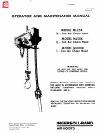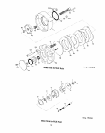
LUBRICATION SPECIFICATION
Whenever a Series MLK Hoist is disassembled for overhaul or replacement of parts, lubricate as follows:
1.
Coat all motor parts with a light film of Ingersoll-Rand Pneu-Lube@Medium Oil No. 50 or a good quality SAE 20 or
20W motor oil before assembling.
2.
Apply a coating of Ingersoll-Rand No. 11 Grease to the Planet Gear Bearings (83) and the Brake Driver Bearing (87) be-
fore assembly.
3.
Lubricate each link of the load chain weekly using a good quality SAE 50 to 90W EP oil. Lubricate the chain more fre-
quently depending on the severity of service.
OPERATION
Always use an air line filter and lubricator with an MLK Hoist. The diameter of the air passage must be at least 1/2” (13
mm). We recommend using No. NFLRU-8 Filter-Lubricator-Regulator installed as close to the inlet of the Hoist as practical.
If quick disconnect fittings are used at the inlet of the Hoist, they must have at least a
3/8"
(9.5 mm) air passage. Use of
smaller fittings will reduce performance.
OPERATING PRACTICES
The two most important aspects of Hoist operation are: (1) Allow only qualified people to operate a Hoist, and (2) Sub-
ject each Hoist to a regular inspection and maintenance procedure.
A qualified operator must be physically competent. He must have no health condition which might affect his ability to re-
act, and he must have good hearing, vision and depth perception. The qualified Hoist operator must be carefully instructed in
his duties and must understand the operation of the Hoist, including a study of the manufacturer’s literature. He must thor-
oughly understand proper methods of hitching loads. He should have a good attitude regarding safety and should refuse to
operate under unsafe conditions.
Proper use of a Hoist begins before a load is lifted. Make certain to:
a. Check to see that the Hoist is directly over the load. Do not lift the load at an angle.
b. Check to see that the Hoist is securely connected to the overhead crane, monorail, trolley or supporting member.
c. Check to see that the load is securely inserted in the hook.
Regular inspection procedures should be set up, rigidly adhered to and recorded by or under the direction of a qualified
person. On Hoists in continuous service, inspection should be made at the beginning of each shift. The items to be checked
include, but are not limited to:
a. Lubrication according to the instructions above.
b. Brakes: Lift a capacity or near capacity load a few inches off the floor and check ability of braking system to stop and
hold the load and without excessive drift.
c. Chain and Hooks: Visually inspect the load chain for cleanliness and lubrication as well as wear or other damage. Note:
Excessive wear may not be apparent upon casual observation. The only positive check is to gauge it according to manufac-
turer’s instructions. Refer to CHAIN REPLACEMENT on page 7. Never operate a Hoist with dry, dirty, worn, damaged
or kinked chain.


















